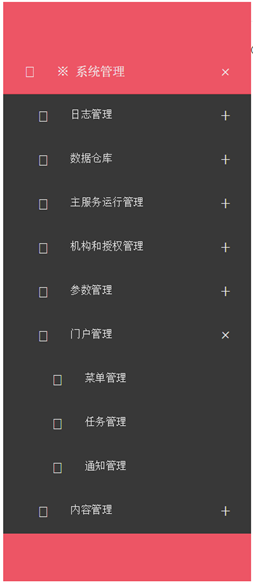9.2.4 .net core 通过ViewComponent封装控件
我们在.net core中还使用了ViewComponent方式生成控件。ViewComponent也是asp.net core的新特性,是对页面部分的渲染,以前PartialView的功能,可以使用ViewComponent来实现。
View Component包含2个部分,一个是类(继承于ViewComponent),和它返回的结果Razor视图(和普通的View视图一样)。
我们还是来看一下以侧边菜单控件为例子,怎么创建一个ViewComponent。侧边菜单控件如下图:

控件的主要逻辑是按照用户和应用程序代码,获取所有已经按照父子结构组织的菜单,传送到页面展示。
上面已经提到,View Component包含2个部分,一个是类,这个类也继承于ViewComponent类。子控件最主要的是重写ViewComponent类的Invoke/InvokeAsync方法:
1 public class SideMenuViewComponent : ViewComponent 2 { 3 private IMenuAppService service; 4 public SideMenuViewComponent(IMenuAppService service) 5 { 6 this.service = service; 7 } 8 9 public IViewComponentResult Invoke(string appCode, UserInfo userInfo) 10 { 11 IEnumerable<MenuDto> menuItems = this.service.GetHierarchy(appCode, userInfo); 12 13 return View("SideMenu", menuItems); 14 } 15 }
再来看ViewComponent的第二部分,就是Razor视图,这里是SideMenu.cshtml:
1 @using MicroStrutLibrary.Presentation.Web.Controls 2 @using MicroStrutLibrary.AppService.Portal 3 @using Microsoft.AspNetCore.Html 4 5 @model IEnumerable<MenuDto> 6 @{ 7 var controlId = System.Guid.NewGuid().ToString("N"); 8 } 9 10 @functions 11 { 12 public IHtmlContent RenderChildren(IEnumerable<MenuDto> menuItems) 13 { 14 string result = "<ul class=\"submenu\" style=\"display: none;\">"; 15 16 foreach (MenuDto itemInfo in menuItems) 17 { 18 var url = Url.Content(string.IsNullOrWhiteSpace(itemInfo.Url) ? "#" : itemInfo.Url); 19 var icon = string.IsNullOrWhiteSpace(itemInfo.IconClass) ? "fa fa-list-ul" : itemInfo.IconClass; 20 var leaf = (itemInfo.IsLeaf && (itemInfo.Children == null || itemInfo.Children.Count() < 1)); 21 22 result += "<li>"; 23 result += $"<a href=\"{Html.Raw(url)}\" target=\"{itemInfo.Target}\" title=\"{itemInfo.MenuDesc}\" data-feature=\"{itemInfo.WinFeature}\" data-leaf=\"{leaf.ToString().ToLower()}\"><i class=\"${Html.Raw(icon)}\"></i><span>{itemInfo.MenuName}</span></a>"; 24 if (!leaf) 25 { 26 result += RenderChildren(itemInfo.Children).ToString(); 27 } 28 } 29 30 result += "</ul>"; 31 return new HtmlString(result); 32 } 33 } 34 <div id="@(controlId)" class="jquery-accordion-menu red"> 35 <div class="jquery-accordion-menu-header"> 36 </div> 37 <ul> 38 @foreach (MenuDto itemInfo in Model) 39 { 40 var url = Url.Content(string.IsNullOrWhiteSpace(itemInfo.Url) ? "#" : itemInfo.Url); 41 var icon = string.IsNullOrWhiteSpace(itemInfo.IconClass) ? "fa fa-list-ul" : itemInfo.IconClass; 42 var leaf = (itemInfo.IsLeaf && (itemInfo.Children == null || itemInfo.Children.Count() < 1)); 43 44 <li> 45 <a href="@Html.Raw(url)" target="@itemInfo.Target" title="@itemInfo.MenuDesc" data-feature="@itemInfo.WinFeature" data-leaf="@(leaf.ToString().ToLower())"> 46 <i class="@Html.Raw(icon)"></i> 47 <span>@itemInfo.MenuName</span> 48 </a> 49 @if (!leaf) 50 { 51 @RenderChildren(itemInfo.Children) 52 } 53 </li> 54 } 55 </ul> 56 <div class="jquery-accordion-menu-footer"> 57 </div> 58 </div> 59 <script> 60 require(['jquery', 'accordionmenu'], function ($) { 61 var $sidebar = $("#@(controlId)"); 62 63 $sidebar.jqueryAccordionMenu(); 64 65 $("a", $sidebar).click(function (e) { 66 var $this = $(this); 67 68 if (!$this.data("leaf")) { 69 e.preventDefault(); 70 } else { 71 var feature = $this.data("feature"); 72 73 if (feature) { 74 e.preventDefault(); 75 window.open($this.attr("href"), $this.attr("target"), feature); 76 } 77 } 78 }); 79 $("li", $sidebar).click(function () { 80 $("li.active", $sidebar).removeClass("active"); 81 $(this).addClass("active"); 82 }); 83 }); 84 </script>
Cshtml中,我们用到了@functions的写法,其实就是相当于在cshtml中编写cs的方法,一般这个方法要求返回的是IHtmlContent。
进阶:资源性视图的应用
按照以往的惯例,我们依旧还一个进阶,说明下ViewComponent中的cshtml作为嵌入的资源该如何写。
其实做法和TagHelper是一样的。首先是嵌入式资源方式,需要在project.json中按照如下方式编写:
"buildOptions": {
"embed": [ "Components/**/*.cshtml", "TagHelpers/**/*.cshtml" ]
}
然后再写一个扩展方法,同上个文档的EmbeddedFileServiceCollectionExtensions,最后是在Startup.cs中使用这个扩展方法。
因为我们的ViewComponet和TagHelper都在同一个WebControls项目中,因此进阶部分的代码根本不需要再写了。这里再重复说明的原因是,在没有写过上述代码的情况下,如何将ViewComponent的Cshtml作为嵌入的资源。



